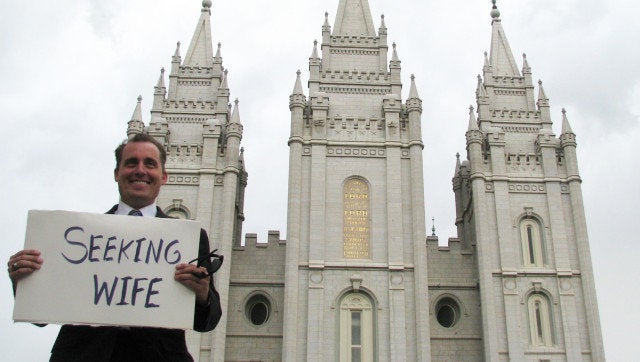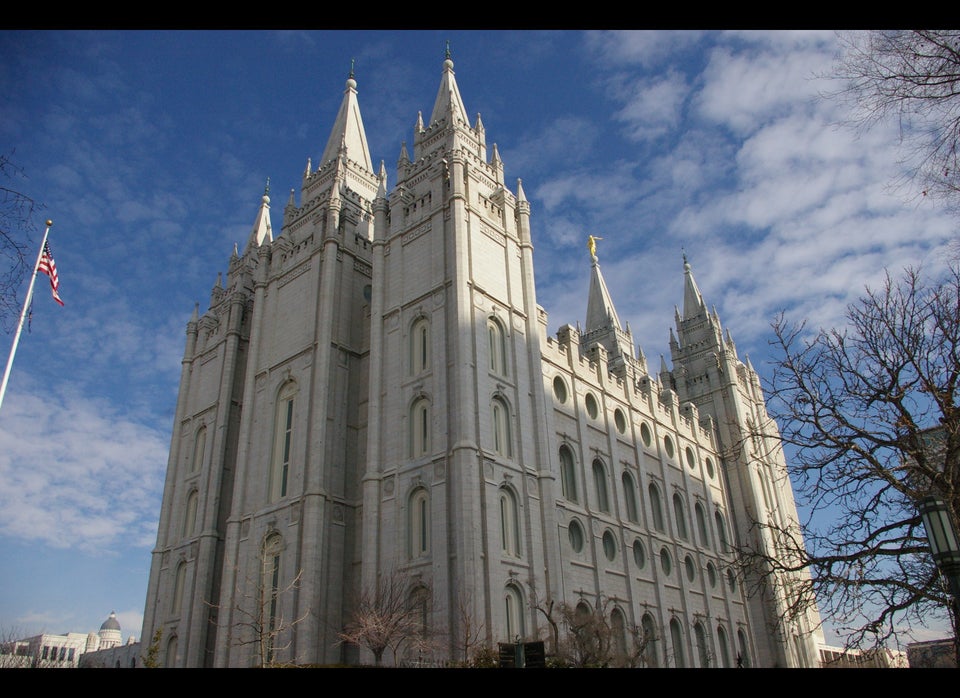
This article is a part of Faith Shift, a Huffington Post series on how changes in demographics, culture, politics and theology are transforming religion in America. Find out more about it here. Previous articles have covered Muslims and Jews.
MIDVALE, Utah -- In this sleepy suburb just south of Salt Lake City, hundreds of men and women recently descended upon one of the hottest, most competitive and nerve-wracking social scenes in the state. They came in their best cars, littering an overcapacity parking lot with double-parked BMWs and Corvettes, and strutted into a bright and airy building in crisp suits and colorful dresses.
Steve Rinehart worked the room, which had the look of a large, converted high school basketball court with rows of folding chairs. He circled the aisles, scoping out the women and peering over shoulders for friends.
"It's a meat market," Rinehart, 36, said with a sigh before giving it a shot. He approached a slim woman in her early 30s who was seated alone. They shook hands. She said she was a librarian. He said he was a lawyer. She gave a lukewarm smile and looked at her phone. "Typical," Rinehart muttered to himself as he walked away before running into an ex-girlfriend who had saved him a chair.
Around him, men and women alike shot wanting glances and often looks of dejection as they exchanged names and pleasantries ahead of the main event.
"Brothers and sisters, welcome to the Sunday sacrament meeting," shouted the bishop above the chatter, before announcing that illegally parked cars were being towed.
As they do each Sunday, Mormons from all over the Salt Lake Valley had flocked to the Union Fort 9th Branch of the Church of Jesus Christ of Latter-day Saints, a large congregation of 800 members that has swelled in recent years. The chapel is one of a unique but quickly growing breed in the faith that's made up exclusively of the unmarried. Each person is between 31 and 45, women outnumber men, and everyone but the bishop is single.
Scripture in hand, the members squeezed between the chairs and into pews to make room for those standing in the back. They praised the Lord and asked Him to fulfill one of the prime and most elusive commandments: a spouse to marry for eternity and, with that union, a required step in the Mormon journey toward God-like exaltation, the ultimate goal in this life and the one hereafter.
The Latter-day Saints church is by many measures one of unparalleled modern success. With a million new members across the globe every three years -- it has 7 million in the U.S. and 14 million worldwide -- the church is one of the fastest-growing religions in the country. It sends tens of thousands of missionaries throughout the world annually, and its faithful are blossoming in South America and Africa.
But despite these triumphs, a key part of the religion has struggled in the U.S. In a faith that's centered almost exclusively around marriage and children, where the highest level of heaven is reserved for the married and where singledom carries not just a social but a spiritual stigma, people like Rinehart are becoming increasingly common.
A crisis of singles has arrived.
Just a few decades ago, the marriage age among Mormons was often as low as 18. Mormons still marry younger than most Americans, but most now marry in their early to mid-20s and singles in their 30s and 40s are quickly on the rise -- once unheard of.
Singledom isn't just something growing among Mormons. About half of American adults, or 100 million, are single, according to the 2010 U.S. Census. Among those, 61 percent have never married. For the first time in history, married couples now amount to less than half of American households. Nationally, women marry at age 26.1 on average, while men marry at 28.2. The rates have gone up by one year for men and two years for women since 2000, and have continually increased since the 1960s.
"There's a higher rate of people wanting higher education, and people are becoming more and more concerned about having a good life. We've seen a rise in a more materialistic viewpoint," says Brian Willoughby, a professor at Brigham Young University who studies family and marriage issues and teaches a course on marriage preparation. The issue crosses into other faiths, but has stood out more among Mormons, whose faith strictly guides them to buck broader trends like premarital sex and living together before marriage.
In Utah, where the majority of the population is Mormon, records from the Office of Vital Records and Statistics show that from 2000 to 2008, the state’s marriage rate dropped faster than the national average. Per 1,000 people, the rate was 10.6 in 2000, compared to 8.7 in 2008. Nationwide, it was 8.7 in 2000 and 7.1 in 2008. That said, Utah still has one of the lowest divorce rates in the country.
Mormon scholars and independent Mormon groups estimate that up to one-third of the church's adult Americans are single, though church officials won't release their own count. Nevertheless, from their temple headquarters in Salt Lake City, the church's General Authorities -- considered living prophets -- have begun admonishing Mormons, instructing them to marry quickly. Mormon leaders have even redrawn the church map, establishing dozens of new age-restricted congregations around the nation, from Arizona to Washington, D.C., in order to facilitate marriage among singles.
"The General Authorities are aware that the church is losing single people, and they are worried about it," says Matthew Bowman, a Mormon who teaches religious history at Hampden-Sydney College and wrote "The Mormon People: The Making of an American Faith." "Growth in the U.S. is about replacement levels, and much of it does come from birth rate."
Among church leaders, the concerns are many. Fewer marriages mean fewer children, which means fewer new members in a faith where conversions are high globally but low within the U.S. Fewer marriages also mean a smaller pool of church leaders to propagate the faith. Congregations are run by unpaid bishops, and only married men are appointed to the roles. Like most religions, single men and women are more likely to drop out of the faith.
But soulmates aren't easy to come across.
* * * * *
"I'm an expert at being single," says Rinehart, who, with his clean-cut hair, polo shirts and blue jeans, fits the stereotypical image of a well-mannered Mormon with conservative style and restrained demeanor.
"I just can't find the right one," he adds. "I don't know if I ever will."
A successful patent lawyer and former web entrepreneur, Rinehart isn't lacking in what he could offer a woman. Trim, broad shouldered, with piercing blue eyes, he's the kind of guy who would stop on the highway to help a stranger with a flat tire, and he's a true believer in the Mormon faith. He carries a white card in his wallet to prove his temple recommend -- a certification that he has followed the rules of the church, received all his sacraments and has tithed, giving 10 percent of his income to the institution.
Rinehart is a homeowner with a knack for earning extra income -- he's converted parts of his 6,000-square-foot house into separate rental apartments -- and he has an array of interests. He collects sports cars and speedboats, speaks Portuguese, plays piano and has songs from Phantom of the Opera memorized. A devout Mormon, he's never drunk alcohol or had sex and, keeping with tradition, he follows Sunday at church with a meal with his parents in his childhood home. He hosts a show on local conservative talk radio and, in his spare time, hikes in the mountains.
Up until about age 21, his life seemed to be in line with a common Mormon male trajectory. Raised in Utah, he was baptized as a boy, and like the majority of Mormon men, was successively ordained to higher orders of the church's priesthood beginning at age 12. During his college years at BYU, he embarked on a two-year mission to Portugal. Most men marry either after completing their missions or after college graduation. Rinehart, who studied computer science at Brigham Young University and later received a law degree at the University of Utah, has gone on dozens of dates and had a few serious girlfriends since those days, but he has never found himself willing to commit. When he was younger, it was he who cut off the relationships. These days, it's often the women who end it.
His longest relationship lasted four-and-a-half years, until he was 34. He broke up with her when he found out she had started to drink, something that's forbidden to Mormons. Not that Rinehart hasn't had his own faults. When he was in college, he developed a Blackjack habit -- Mormons aren't supposed to gamble -- and suffered breakups as a result.
A more recent girlfriend was too demanding. Another was too jealous. Others were kindhearted and spiritual, but couldn't keep his attention.
"I have to take seriously that there is some sort of internal psychological resistance to settling down. I don't think there is, but other people do," he says. Most of his life, though, his mind has just been on other pursuits, such as his career.
An overworked lawyer, Rinehart sometimes just can't find time for the dating scene, where up to a dozen singles dances and Mormon socials are organized each night in the Salt Lake Valley. And for all his good traits, Rinehart's confidence has waned over the years, with him worrying about everything from where to take women on a date to his receding hairline.
"Maybe girls are uncomfortable one-on-one. Rumor has it that there is a problem at the higher church level with singles who date and hang out in groups," Rinehart says.
It's true. In public speeches, the church's general authorities have started to chastise single Mormons for opting to casually "hang out" with the opposite sex instead of dating with an eye toward marriage.
"If you choose wisely and if you are committed to the success of your marriage, there is nothing in this life which will bring you greater happiness," the church's highest living authority, President Thomas S. Monson, said last year at the General Conference, a forum broadcasted from church headquarters in Salt Lake City.
Another general authority, Elder Richard G. Scott, hit at it more directly at the same conference: "If you are a young man of appropriate age and are not married, don't waste time in idle pursuits," he said. "Get on with life and focus on getting married. Don't just coast through this period of life."
Feeling out of step with the dating scene -- and a bit hopeless -- Rinehart has lately opted for "hanging out."
Gathered at the Cheesecake Factory recently over mocktails and pasta, he and a dozen single friends (it's become harder to keep in touch with the married ones) debated their evolving views on dating and marriage. Most were in their 30s. While strong in their own faith, a few were considering dating non-Mormons.
"The older I get, the more tolerant I am of people who live their life religiously or not. The older I am, the less I am judgmental of people who want to live the gospel -- if they are Mormon -- or don't if they are not and continue to be themselves," said Trevor Bruford, a 36-year-old IT administrator and divorcee.
Others shared concerns with dating outside the faith.
"But I do want to be in a situation with someone who has my same standards because it would be so hard to wake up with someone who didn't do what we do in our faith," said Olivia Luce, 35.
Katie Winn, a 29-year-old college adviser and ex-girlfriend of Rinehart's, agreed. "Just, our lifestyles are so different. How many guys could I date who are not LDS who would wait to have sex after marriage?"
Rinehart shot back: "How many LDS ones will?"
While most faiths discourage sex before marriage, the Mormon church spells out its rules directly.
"Before marriage, do not do anything to arouse the powerful emotions that must be expressed only in marriage," says an official LDS guide. "Do not participate in passionate kissing, lie on top of another person, or touch the private, sacred parts of another person’s body, with or without clothing. Do not allow anyone to do that with you. Do not arouse those emotions in your own body."
Rinehart, who has readily confessed his sins to his bishops and has at times been temporarily barred from receiving sacrament as a result, admits that he has gone "a little too far." In the heat of the moment, he has crossed the line of "passionate kissing." He has touched women through their clothing and let them do the same to him, but he has never been naked with the opposite sex. Once, on a vacation with a girlfriend, he rented a hotel with two beds to avoid any temptation. "That's even a little risky for some Mormons," he says.
* * * * *
Churches for Mormon singles have existed since 1973, when they were first established to cater to the many single college-aged members that swelled the ranks of Brigham Young University. But in the decades since, the number of singles churches have quickly grown, and expanded into two categories: Young Single Adult wards for Mormons under 31, and Mid-single Adult wards for those in Rinehart's age range. Last year, Mormon leaders for the first time formally created stakes, akin to Catholic dioceses, to administer the growing number of Mormon churches for young singles.
Internally, Mormons have been conflicted over the strategy of putting singles together in a church. There are debates about whether focusing on marriage at church takes away from the spiritual growth of worship. And it's unclear if it works. Over 13 years of attending singles churches, Rinehart has come out of it with one girlfriend. The church won't release it's data on success rates, but other single Mormons have shared similar stories.
What's clear is that the singles problem isn't going away.
"When I started in this position three years ago, we had 229 members. Today, we have 800," says Robert Norton, the bishop of the singles church Rinehart attends in Midvale. He estimates there are tens of thousands of more Mormon singles within his congregation's boundaries, which encompasses a third of Salt Lake County, who don't attend his congregation.
"We try to provide an environment where they feel comfortable, and where they can serve in leadership," he says, adding that the church recently celebrated its 82nd wedding in his years leading it. "The trend out there in the world is to put off marriage. We don't agree with that or with cohabiting, but a lot of times it's education, jobs, those kinds of things that are getting in the way of making a commitment."
Rinehart's approach to finding women has varied. He used to drive to several singles congregations in one day, hoping to meet the right woman if he cast his net wide enough. These days, he only looks for women at Norton's congregation. But he's also missed being around older, wiser married men and women in the church and the energy of young children.
Mormons meet for three hours each Sunday in three consecutive meetings. The first meeting is split by gender, with men attending the priesthood meeting and women participating in the Relief Society, an educational and philanthropic group. It's followed by a mix-gender scripture study and the sacrament meeting, where Mormons drink water and eat bread as a symbol of Jesus Christ. That's the part Rinehart attends among the mixed congregation of singles. For the first two meetings, he has started to attend his local church that's largely made up of families.
And on a recent Sunday in the local family church, Rinehart was confronted with singledom head-on. He was in the Fruit Heights chapel, a small congregation near his home, attending the priesthood meeting. The day's lesson would cover service to family and community, from kin to gentiles. Rinehart's mind wandered to the former: a future with a wife and kids, maybe five like in his family, where he is the oldest, has two married younger brothers and is an uncle to six.
About two dozen Mormon men ambled into the chapel and caught up on the past week and the most recent scripture lessons. They sat down ready to study and pray. But before any of that could began, the church elder about to lead the service took a peculiar tally.
"So, anybody engaged?" he quipped, though he meant it in all seriousness. It was a question Rinehart dreaded and one that rarely arises at the singles-only church.
Two scruffy young men in their early 20s, recently back from stints as missionaries, proudly stood up to name their wives to-be. Across the aisle, soon-to-be grandfathers clapped and cheered.
Rinehart slouched down. Single, and once again singled out, he sighed.
He thought back to when he was a child and first learning the theology and traditions of the church. He would attend chapel with his parents and siblings, and there would be whispers about one of the men in the crowd.
"He was 37 and everyone would talk about him. 'Why is he not married? What is going on?' I think his name was Murphy," Rinehart recalled. "I'm really pushing it. I'm about a year away from being in that situation. And it makes me want to cry."
Click through the slideshow to see most and least Mormon states in the United States:

